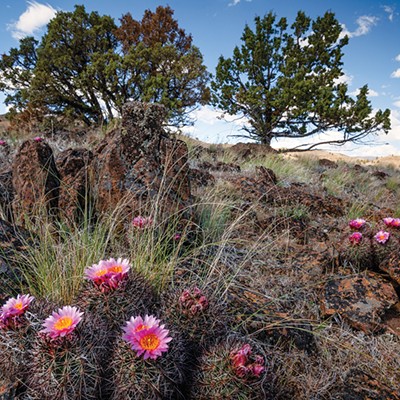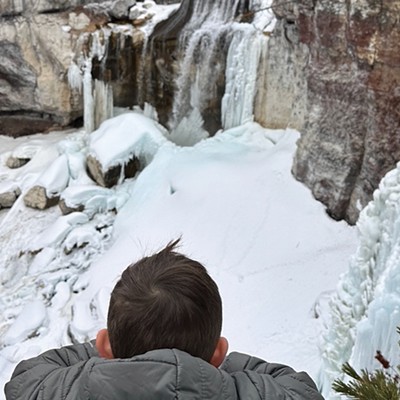Nearly one year ago, Mike Belchik, a senior biologist for the Yurok Tribe, was overseeing an emergency laboratory on a remote gravel bar in the Klamath River on the tribe's Northern California reservation. That morning, crews had netted two dozen salmon from a 20-mile stretch of the lower river. Now they were inspecting their catch for a parasite dubbed "the Ebola of Klamath salmon."
Working quickly, the men snipped a layer of glistening gill tissue from each fish and slid it under a microscope. The parasite—a protozoan named Ichthyophthirius multifiliis, or simply Ich—is salt-colored and less than a millimeter wide, with a fringe of madly fluttering hairs. Belchik and his crew had monitored for it all summer, but only that weekend had infected fish begun appearing in their nets.
In 2002, Ich killed some 70,000 king salmon in the Klamath—the largest such die-off ever recorded on the West Coast. Afterward, the parasite population declined below detection, but it is native to the river, and there was reason to fear its resurgence.
Last September, California was already three years into perhaps its worst drought in more than a millennium, and the Klamath was low and warm. In slow water thick with fish, Ich can reproduce rapidly. Thousands might feast on a single salmon. Once engorged with blood, they drop off and anchor to the river bottom. Then each one bursts open, releasing up to 1,000 offspring. The cycle can take as little as a week. "It felt like a catastrophe was looming," Belchik says.
The Yurok crews were trying to determine whether water should be released from reservoirs upstream in an attempt to disrupt the parasite's life cycle. Ich are relatively poor swimmers and can survive only a few days without a meal. Increased flows, the thinking goes, might disperse the parasites while letting salmon migrate out of infested holding pools, but such a tactic had never been attempted on an outbreak already underway. No one knew whether it would work in a fishery stressed nearly to failure by drought and diversions.
After the 2002 die-off, tribes, agencies, dam owners, and other parties agreed to release water from reservoirs on the Trinity River, the Klamath's largest tributary, if at least 30 parasites were found in a single layer of gills in at least 5 percent of captured fish. By 1 pm, Yurok crews had found Ich in nearly half of their catch.
Belchik dug out his cellphone and called the reservoirs' managers. Send water, he said—and fast.
The upper Klamath River is impounded by seven dams, which serve some 170,000 acres of arid southern Oregon farmland. But downstream, the river flows unimpeded for 190 miles before spilling into the Pacific Ocean. This stretch and its tributaries support the third-richest salmon runs in the Lower 48. In an average year, 120,000 kings and a few hundred threatened coho muscle through these waters to spawn.
Relations between farmers and the basin's salmon-dependent tribes are notoriously tense, and in 2001, they snapped. That spring, during a severe drought, federal wildlife managers shut off agricultural diversions to protect coho and struggling sucker fish. Farmers, who had already sown potatoes, hay, wheat and other crops, were furious. They protested by forcing open a head gate and refilling an irrigation ditch with buckets.
The conflict caught the attention of the Bush administration, and the next summer—also dry—irrigators received their full water allotments. The Yurok and others protested that the fish needed more water, but "nobody was looking for Ich," Belchik recalls. The parasite was known for ravaging farmed fish, but such kills were almost unheard of in the wild.
By mid-September 2002, flows in the lower Klamath had dwindled to about 60 percent of average. The Yurok were celebrating an important ceremony just above the river when children began carrying dead salmon up to the dance grounds. Fish were dying by the thousands, infested—with Ich.
"It went from nothing, to major catastrophe, in a span of a few days," Belchik says.
Due to the die-off, the commercial Pacific salmon season in Northern California and southern Oregon was sharply curtailed in 2004 and 2005, and was declared a disaster by the National Marine Fisheries Service in 2006. No one felt the kill like the Yurok. Their reservation, home to roughly 1,000 tribal members, flanks 44 miles of the lower river. The Yurok ply that territory for salmon, steelhead, sturgeon and Pacific lamprey to feed their families. "We're a fishing people," says Chairman Thomas O'Rourke. "It was sickening."
In 2014, the Bureau of Reclamation reacted quickly when it learned another disaster was brewing. The morning after Belchik called, the agency began releasing enough water to double flows in the lower Klamath for a week. Belchik wondered how the parasite would respond. Since the 2002 kill, his crews had inspected salmon weekly during the fall runs. Now they stepped up their effort.
Their findings dismayed them. Crews had initially looked for 30 parasites in each fish—the threshold for the emergency response—and then stopped counting, even if more were present. But Belchik soon realized they were overlooking valuable data. He told workers to count to 100, then to 200. Eventually, finding nearly 1,000 parasites in some gills, he said, "Just count them all."
To an extent, tribes and biologists had seen the problem coming. Since the middle of summer, they had pushed the Bureau to release extra water. Such releases, purely precautionary, were a critical component of the post-2002 response measures, but had become increasingly controversial. In 2003, 2004, and 2012, the Bureau granted them, without any sign of an Ich outbreak. In 2013, however, the releases triggered a legal challenge from Central Valley irrigators. Last summer, with water supplies exceptionally limited, the agency unexpectedly announced it wouldn't release any water until infected fish were found.
The Bureau's hesitation sparked a backlash. In early August, members of the Hoopa Valley Tribe, on the Trinity, approached Interior Secretary Sally Jewell at a wildfire meeting in nearby Redding. A week later, tribal members and others protested outside the agency's Sacramento office. The Bureau eventually agreed to release preventative flows, but it was late August by the time water started flowing. Ich would appear soon after, necessitating the unprecedented emergency releases of mid-September.
All told, some 80,000 acre-feet poured downstream last summer to protect salmon—more than twice as much as in previous seasons.
By mid-October, the salmon had migrated off the Yurok Reservation, but infection levels remained severe. Belchik was still anxious to keep tabs on the outbreak, but he was forced to postpone his monitoring until almost November, when he received permission to inspect salmon arriving in a hatchery at Iron Gate Dam, the upper limit of the Klamath run.
What he saw surprised him: not much Ich.
The outbreak had apparently dissipated somewhere between the Yurok Reservation and the dams. An unusual number of salmon in the Trinity had failed to spawn, perhaps as a result of Ich-induced stress, but no large-scale die-off occurred. "Now," said Belchik, "begins the long process of figuring out what exactly happened."
Of the many questions biologists are asking—How many parasites can a salmon withstand before dying? When, exactly, did the outbreak start, peak and subside?—one of the most critical is whether the mid-September emergency flows averted a catastrophe. Belchik cautions that Ich outbreaks are rare and poorly understood, but, he says, "the leading hypothesis is that, yeah, we saved the fish."
The triumph may prove precarious. Belchik and others think Ich's re-appearance last year was prompted not just by years of drought, but by long-term ecological degradation caused by dams—degradation that's becoming more problematic in the warming West. The 2002 catastrophe prompted a landmark series of settlements, the Klamath Agreements, intended to resolve water conflicts in the basin, partly by removing four dams from the river—a great benefit for salmon. But the enabling legislation has stalled in Congress. For now, Klamath salmon, and the tribes that rely on them, must make do with conditions at hand.
This article was originally published in the April 27, 2015, issue of High Country News (hcn.org).





















